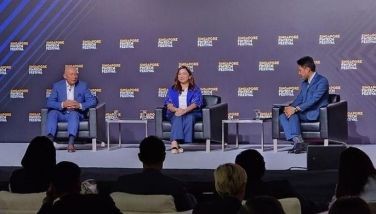The gift of productivity
December 24, 2001 | 12:00am
Christmas is a time for sharing.
When entrepreneurs improve their productivity, the benefits must spill over to customers and workers alike. And if such improvements are done as a matter of course, then sharing benefits becomes a year-round activity. Christmas every day? Why not!
Often, business owners look for better ways of doing things. These are supposed to lead to better profitability or returns. While the entrepreneur can be the primary source of improvements, the entrepreneur is not an endless nor an exclusive source. More importantly, the role of the entrepreneur is the creation and management of an improvement environment within the enterprise.
The environment naturally makes the organization (all the way down to the last person) a continuous source of ideas that can potentially improve the business. The best source of improvement is the person doing the task. But persons doing the task often withhold improvement ideas. The equating of improvement ideas to retrenchment prevents the spawning of improvement ideas. The equation that prevents the development of an improvement culture is: Productivity improvement equals retrenchment of people.
Q. How did the equation come about?
A. In the past, all retrenchment and early retirement programs have been premised on, or even worse, have been disguised as, a productivity improvement program. This is the reason why the burden of improving productivity has been put on the entrepreneur or some top official of the company. People directly involved in doing the tasks that have to be improved, therefore, refuse to contribute to the improvement process. They are worried that they may be the source of not only improving the task but, inadvertently, of the removal of fellow employees.
Q. How can this equation be altered or changed?
A. First, let us call a spade a spade. If it is a retrenchment or an early retirement program, then indicate it as such. Stop hiding the real agenda. Stop calling it a productivity improvement program.
Second, stop living in this paradigm. The best way to improve a business is by increasing profits through the acceleration of revenue at a rate faster than cost and not by simply reducing cost.
Third, start proving to the organization that productivity and profit improvement programs can also mean adding people or creating more jobs.
Q. How can you increase productivity or profits by adding people? Isn’t that the opposite?
A. The old paradigm will say it is the opposite. The entrepreneurial thinking says otherwise. If one adds people to the bottleneck areas, then productivity and profits will go up. You will increase output or the capacity of your system.
Q. But what if I am already serving all the demand for my product or service? What if I cannot sell additional output or capacity?
A. We often hear remarks like "the market can only absorb so much" or that "the only way to increase profits or productivity is by reducing costs".
I disagree. This is not a new science.
Henry Ford did it with the automobile. When he increased productivity, he also passed on the effects of the improvement to the customers. This resulted in an increased volume of demand.
Any productivity improvement that is shared with the customer will be rewarded with increased demand. A productivity improvement that is not shared with the customer will never increase demand.
Q. How do I prove to my organization that productivity improvement does not mean removing people?
A. Let the next productivity improvement program result in adding people in areas where there will be the greatest impact in increased volume of output. This can be in terms of additional preventive-oriented tasks that will reduce rejects. This can also be in terms of adding people to decrease the waiting time of customers and, therefore, sell more per unit time. There are many ways to increase revenue faster than the cost of adding people.
In addition, share with both the customers and the organization the benefits of the improved productivity. For customers, it need not be necessarily in terms of a price reduction. It may be in quality enhancement. For the organization, it need not be in terms of increased income per person, but by way of increased job satisfaction.
Q. Are there examples of these in the Philippines?
A. Yes, some of the student-entrepreneurs in the Master in Entrepreneurship program of AIM have successfully done it.
A person in the garments game added people in pre-production and quality management. This resulted in a reduction of rejects and, therefore, a reduction in costs and increased sales volume from the same set of materials.
A retailer has increased the number of outlets by 10 and has, therefore, increased the number of people in retail operations. This has resulted in increased sales of almost P10 million a year.
A trader of generic products increased revenues by creating new services for customers. The new services have created new jobs and have become another source of revenue.
Q. How do I know that I have succeeded in creating the improvement environment? How can I sustain it?
A. When the people in the organization freely volunteer ideas for improvement, then you have arrived. When the people in the organization help each other improve their respective work, you have arrived. When the people in the organization do the two things above without any expectation of monetary incentives, you have created and managed the environment for improvement.
However, to ensure sustainability of the environment, do not forget to share the results of the improvement programs. Share it with your customers and your organization. And have a merry Christmas all-year round.
(Alejandrino Ferreria is the associate dean of the Asian Center for Entrepreneurship of the Asian Institute of Management. For further information/comments, you may mail him at: [email protected]. Published "Enterpreneur’s Help-line" columns can be viewed at www//:aim.edu.ph).
When entrepreneurs improve their productivity, the benefits must spill over to customers and workers alike. And if such improvements are done as a matter of course, then sharing benefits becomes a year-round activity. Christmas every day? Why not!
Often, business owners look for better ways of doing things. These are supposed to lead to better profitability or returns. While the entrepreneur can be the primary source of improvements, the entrepreneur is not an endless nor an exclusive source. More importantly, the role of the entrepreneur is the creation and management of an improvement environment within the enterprise.
The environment naturally makes the organization (all the way down to the last person) a continuous source of ideas that can potentially improve the business. The best source of improvement is the person doing the task. But persons doing the task often withhold improvement ideas. The equating of improvement ideas to retrenchment prevents the spawning of improvement ideas. The equation that prevents the development of an improvement culture is: Productivity improvement equals retrenchment of people.
Q. How did the equation come about?
A. In the past, all retrenchment and early retirement programs have been premised on, or even worse, have been disguised as, a productivity improvement program. This is the reason why the burden of improving productivity has been put on the entrepreneur or some top official of the company. People directly involved in doing the tasks that have to be improved, therefore, refuse to contribute to the improvement process. They are worried that they may be the source of not only improving the task but, inadvertently, of the removal of fellow employees.
Q. How can this equation be altered or changed?
A. First, let us call a spade a spade. If it is a retrenchment or an early retirement program, then indicate it as such. Stop hiding the real agenda. Stop calling it a productivity improvement program.
Second, stop living in this paradigm. The best way to improve a business is by increasing profits through the acceleration of revenue at a rate faster than cost and not by simply reducing cost.
Third, start proving to the organization that productivity and profit improvement programs can also mean adding people or creating more jobs.
Q. How can you increase productivity or profits by adding people? Isn’t that the opposite?
A. The old paradigm will say it is the opposite. The entrepreneurial thinking says otherwise. If one adds people to the bottleneck areas, then productivity and profits will go up. You will increase output or the capacity of your system.
Q. But what if I am already serving all the demand for my product or service? What if I cannot sell additional output or capacity?
A. We often hear remarks like "the market can only absorb so much" or that "the only way to increase profits or productivity is by reducing costs".
I disagree. This is not a new science.
Henry Ford did it with the automobile. When he increased productivity, he also passed on the effects of the improvement to the customers. This resulted in an increased volume of demand.
Any productivity improvement that is shared with the customer will be rewarded with increased demand. A productivity improvement that is not shared with the customer will never increase demand.
Q. How do I prove to my organization that productivity improvement does not mean removing people?
A. Let the next productivity improvement program result in adding people in areas where there will be the greatest impact in increased volume of output. This can be in terms of additional preventive-oriented tasks that will reduce rejects. This can also be in terms of adding people to decrease the waiting time of customers and, therefore, sell more per unit time. There are many ways to increase revenue faster than the cost of adding people.
In addition, share with both the customers and the organization the benefits of the improved productivity. For customers, it need not be necessarily in terms of a price reduction. It may be in quality enhancement. For the organization, it need not be in terms of increased income per person, but by way of increased job satisfaction.
Q. Are there examples of these in the Philippines?
A. Yes, some of the student-entrepreneurs in the Master in Entrepreneurship program of AIM have successfully done it.
A person in the garments game added people in pre-production and quality management. This resulted in a reduction of rejects and, therefore, a reduction in costs and increased sales volume from the same set of materials.
A retailer has increased the number of outlets by 10 and has, therefore, increased the number of people in retail operations. This has resulted in increased sales of almost P10 million a year.
A trader of generic products increased revenues by creating new services for customers. The new services have created new jobs and have become another source of revenue.
Q. How do I know that I have succeeded in creating the improvement environment? How can I sustain it?
A. When the people in the organization freely volunteer ideas for improvement, then you have arrived. When the people in the organization help each other improve their respective work, you have arrived. When the people in the organization do the two things above without any expectation of monetary incentives, you have created and managed the environment for improvement.
However, to ensure sustainability of the environment, do not forget to share the results of the improvement programs. Share it with your customers and your organization. And have a merry Christmas all-year round.
(Alejandrino Ferreria is the associate dean of the Asian Center for Entrepreneurship of the Asian Institute of Management. For further information/comments, you may mail him at: [email protected]. Published "Enterpreneur’s Help-line" columns can be viewed at www//:aim.edu.ph).
BrandSpace Articles
<
>
- Latest
Latest
Latest
February 22, 2024 - 3:17pm
February 22, 2024 - 3:17pm
December 28, 2023 - 12:00am
December 28, 2023 - 12:00am
December 11, 2023 - 11:00am
December 11, 2023 - 11:00am
November 23, 2023 - 4:35pm
November 23, 2023 - 4:35pm
October 16, 2023 - 5:00pm
October 16, 2023 - 5:00pm
Recommended






























